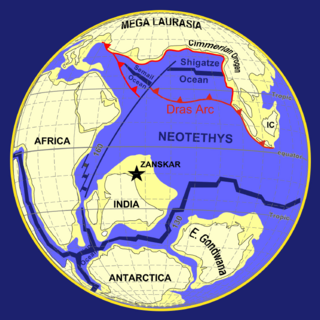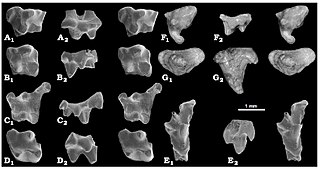
Marsupials are a diverse group of mammals belonging to the infraclass Marsupialia. They are natively found in Australasia, Wallacea, and the Americas. One of the defining features of marsupials is their unique reproductive strategy, where the young are born in a relatively undeveloped state and then nurtured within a pouch on their mother's abdomen.

Multituberculata is an extinct order of rodent-like mammals with a fossil record spanning over 130 million years. They first appeared in the Middle Jurassic, and reached a peak diversity during the Late Cretaceous and Paleocene. They eventually declined from the mid-Paleocene onwards, disappearing from the known fossil record in the late Eocene. They are the most diverse order of Mesozoic mammals with more than 200 species known, ranging from mouse-sized to beaver-sized. These species occupied a diversity of ecological niches, ranging from burrow-dwelling to squirrel-like arborealism to jerboa-like hoppers. Multituberculates are usually placed as crown mammals outside either of the two main groups of living mammals—Theria, including placentals and marsupials, and Monotremata—but usually as closer to Theria than to monotremes. They are considered to be closely related to Euharamiyida and Gondwanatheria as part of Allotheria.

Metatheria is a mammalian clade that includes all mammals more closely related to marsupials than to placentals. First proposed by Thomas Henry Huxley in 1880, it is a more inclusive group than the marsupials; it contains all marsupials as well as many extinct non-marsupial relatives. It is one of two groups placed in the clade Theria alongside Eutheria, which contains the placentals.

Sparassodonta is an extinct order of carnivorous metatherian mammals native to South America, related to modern marsupials. They were once considered to be true marsupials, but are now thought to be a separate side branch that split before the last common ancestor of all modern marsupials.

Herpetotherium is an extinct genus of metatherian mammal, belonging to the possibly paraphyletic family Herpetotheriidae. Native to North America from the Eocene to Early Miocene, fossils have been found in California, Oregon, Texas, Florida, Montana, Wyoming, Colorado, North and South Dakota, Nebraska, and Saskatchewan. The oldest species, H. knighti, is dated to around 50.3 mya, and the most recent, an unnamed species, may be as recent as 15.97 mya. A morphological analysis of marsupials and basal metatherians conducted in 2007 found Herpetotherium to be the sister group to extant marsupials. It is the youngest known metatherian from North America until the migration of the Virginia opossum from South America within the last 2 million years.

Herpetotheriidae is an extinct family of metatherians, closely related to marsupials. Species of this family are generally reconstructed as terrestrial, and are considered morphologically similar to modern opossums. Fossils of herpetotheriids come from North America, Asia, Europe, Africa, and perhaps South America. The oldest representative is Maastrichtidelphys from the latest Cretaceous (Maastrichtian) of the Netherlands and the youngest member is Amphiperatherium from the Middle Miocene of Europe. The group has been suggested to be paraphyletic, with an analysis of petrosal anatomy finding that North American Herpetotherium was more closely related to marsupials than the European Peratherium and Amphiperatherium.
Palaeoamasia is an extinct herbivorous paenungulate mammal of the embrithopod order, making it distantly related to elephants, sirenians, and hyraxes. Palaeoamasia fossils have been found in Turkish deposits of the Çeltek Formation, dating to the Ypresian. It has unique bilophodont upper molars, an embrithopod synapomorphy.
LACM 149371 is an enigmatic fossil mammalian tooth from the Paleogene of Peru. It is from the Santa Rosa fossil site, which is of uncertain age but possibly late Eocene or Oligocene. The tooth is poorly preserved and may have been degraded by acidic water or because it passed through a predator's digestive tract. Its largest dimension is 2.65 mm. It is triangular in shape and bears six cusps that surround the middle of the tooth, where there are three basins (fossae). Crests connects the cusps and separate the fossae. The microscopic structure of the enamel is poorly preserved.
The Macropodidae are an extant family of marsupial with the distinction of the ability to move bipedally on the hind legs, sometimes by jumping, as well as quadrupedally. They are herbivores, but some fossil genera like Ekaltadeta are hypothesised to have been carnivores. The taxonomic affiliations within the family and with other groups of marsupials is still in flux.
The Murgon fossil site is a paleontological site of early Eocene age in south-eastern Queensland, Australia. It lies near the town of Murgon, some 270 km north-west of Brisbane. The Murgon site is important as the only site on the continent with a diverse range of vertebrate fossils dating from the early Paleogene Period, making it a crucial period in mammal evolution. It is also important in demonstrating Australia's Gondwanan links with South America in the form of similar fossils from the two continents.

Anachlysictis gracilis is an extinct carnivorous mammal belonging to the group Sparassodonta, which were metatherians that inhabited South America during the Cenozoic. Anachlysictis is the first record of such borhyaenoids in northern South America, and also the most primitive known member of the family Thylacosmilidae, a group of predators equipped with "saber teeth". It was also the only confirmed record of a thylacosmilid that did not belong to the genus Thylacosmilus until the official publication of Patagosmilus in 2010.
Dermotherium is a genus of fossil mammals closely related to the living colugos, a small group of gliding mammals from Southeast Asia. Two species are recognized: D. major from the Late Eocene of Thailand, based on a single fragment of the lower jaw, and D. chimaera from the Late Oligocene of Thailand, known from three fragments of the lower jaw and two isolated upper molars. In addition, a single isolated upper molar from the Early Oligocene of Pakistan has been tentatively assigned to D. chimaera. All sites where fossils of Dermotherium have been found were probably forested environments and the fossil species were probably forest dwellers like living colugos, but whether they had the gliding adaptations of the living species is unknown.

Stagodontidae is an extinct family of carnivorous metatherian mammals that inhabited North America and Europe during the late Cretaceous, and possibly to the Eocene in South America.
Siamoperadectes is a genus of non-marsupial metatherian from the Miocene of Thailand. A member of Peradectidae, it is the first member of its clade known from South Asia, and among the last non-marsupial metatherians.

Anatoliadelphys maasae is an extinct genus of predatory metatherian mammal from the Eocene of Anatolia. It was an arboreal, cat-sized animal, with powerful crushing jaws similar to those of the modern Tasmanian devil. Although most mammalian predators of the northern hemisphere in this time period were placentals, Europe was an archipelago, and the island landmass now forming Turkey might have been devoid of competing mammalian predators, though this may not matter since other carnivorous metatherians are also known from the Cenozoic in the Northern Hemisphere. Nonetheless, it stands as a reminder that mammalian faunas in the Paleogene of the Northern Hemisphere were more complex than previously thought, and metatherians did not immediately lose their hold as major predators after their success in the Cretaceous.

Insular India was an isolated landmass which became the Indian subcontinent. Across the latter stages of the Cretaceous and most of the Paleocene, following the breakup of Gondwana, the Indian subcontinent remained an isolated landmass as the Indian Plate drifted across the Tethys Ocean, forming the Indian Ocean. The process of India's separation from Madagascar first began 88 million years ago, but complete isolation only occurred towards the end of the Maastrichtian, a process that has been suggested to be the creation of the Deccan Traps. Soon after, the land mass moved northward rather quickly, until contact with Asia was established 55 million years ago. Even then, both landmasses did not become fully united until around 35 million years ago, and periods of isolation occurred as recently as 24 million years ago.

Peradectes is an extinct genus of small metatherian mammals known from the latest Cretaceous to Eocene of North and South America and Europe. The first discovered fossil of P. elegans, was one of 15 Peradectes specimens described in 1921 from the Mason pocket fossil beds in Colorado. The monophyly of the genus has been questioned.

Gypsonictops is an extinct genus of leptictidan mammals of the family Gypsonictopidae, which was described in 1927 by George Gaylord Simpson. Species in this genus were small mammals and the first representatives of the order Leptictida, that appeared during the Upper Cretaceous.

Holoclemensia is an extinct genus of mammal of uncertain phylogenetic placement. It lived during the Early Cretaceous and its fossil remains were discovered in Texas.

Amphiperatherium is an extinct genus of metatherian mammal, closely related to marsupials. It ranged from the Early Eocene to the Middle Miocene in Europe. It is the most recent metatherian known from the continent.












